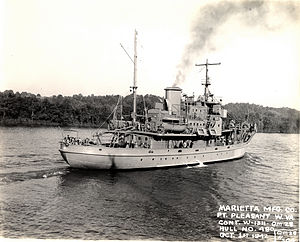Mine planter
Mine planter and the earlier "torpedo planter" was a term used for mine warfare ships into the early days of World War I. In later terminology, particularly in the United States, a mine planter was a ship specifically designed to install controlled mines or contact mines in coastal fortifications. This type of ship diverged in both function and design from a ship operating as a naval minelayer. Though the vessel may be seagoing it is not designed to lay large numbers of mines in open sea. A mine planter was designed to place mines in exact locations so that they might be fired individually or as a group from shore when observers noted a target to be at or near a designated mine's position. The terms and types of specialized ship existed from the 1860s where "torpedoes" were made famous in the American Civil War until the demise of large, fixed coastal fortifications brought on by the changes of World War II.
The earliest mines were the "torpedos" associated with harbor defenses. Thus the vessels required to place the torpedoes were termed torpedo planters with the equipment evolving with the mines. For example, the record of the Sixtieth Congress there is mention of "procurement of one torpedo planter and two launches for the Hawaiian Islands" in connection with submarine mines in Hawaiian Island defenses. In the United States and some other countries there was a coastal defense "torpedo service" that required vessels capable of placing the devices and associated firing cables as early as the late 19th Century. By 1904 the first vessels specifically designed for this work were under construction in the United States.
The outbreak of naval warfare in World War I saw extensive use of sea mines. The first naval ships destined to be minelayers were first termed mine planters as seen in Navy ship references. The term appears to be used interchangeably in naval usage during that period. For example, in an address to the U.S. Navy ships of Mine Squadron One at Portland, England Admiral Sims used the term "mine layer" while the introduction speaks of the men assembled from the "mine planters". As the distinct difference between "planting" individual mines and "laying" mine barrages by dropping large numbers of mines at sea emerged the term minelayer began to apply to the naval vessels engaged and built for this type of operation.
In the coastal defense system the usage of mine planter was continued. In the United States 1918 saw the creation of the U. S. Army Mine Planter Service (USAMPS). The designation of mine planter was continued for the largest specialized ships of that service until the effective end of the service in the closing years of World War II. During that time the formal usage of Mine Planter was applied to the ships and their names were prefixed by U.S. Army Mine Planter (USAMP). The USAMPS was formally ended in 1954 by Congress in the Warrant Officer Personnel Act some five years after its vessels had been dispersed.
...
Wikipedia

